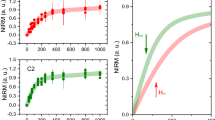Abstract
SCRAPIE, a naturally occurring slow virus disease of sheep and goats, has been transmitted experimentally to the mouse, rat, gerbil, mink, hamster, vole and monkey1. The agent has shown an unusual resistance to ultraviolet irradiation2, nucleases3 and β-propiolactone4. The precise nature of the scrapie agent, however, has yet to be defined. It is not known whether it is a virus, some type of self-replicating cell membrane, or part of a membrane5. The viroid hypothesis of the scrapie agent of Diener6 has been discounted7,8. Several different particles have been seen in thin sections of naturally and experimentally infected scrapie tissues9–11. As repeated fluorocarbon extractions of mink tissues infected with Aleutian disease virus (ADV), which causes persistent infection of mink, have resulted in isolation of the virus12,13, we thought it worthwhile to apply the same physico-chemical techniques in an attempt to isolate virus from mouse brains infected with scrapie agent.
This is a preview of subscription content, access via your institution
Access options
Subscribe to this journal
Receive 51 print issues and online access
$199.00 per year
only $3.90 per issue
Buy this article
- Purchase on Springer Link
- Instant access to full article PDF
Prices may be subject to local taxes which are calculated during checkout
Similar content being viewed by others
References
Gibbs, C. J., and Gajdusek, D. C., Science, 182, 67–68 (1973).
Alper, T., Cramp, W. A., Haig, D. A., and Clarke, M. C., Nature, 214, 764–766 (1967).
Gibbons, R. A., and Hunter, G. D., Nature, 215, 1041–1043 (1967).
Haig, D. A., and Clarke, M. C., J. gen. Virol, 3, 281–283 (1968).
Millson, G. C., Hunter, G. D., and Kimberlin, R. H., J. comp. Path., 81, 255–265 (1971).
Diener, T. O., Nature new Biol., 235, 218–219 (1972).
Marsh, R. F., Semancik, J. S., Medappa, K. C., Hanson, R. P., and Rueckert, R. R., J. Virol., 13, 993–996 (1974).
Ward, R. L., Porter, D. D., and Stevens, J. G., J. Virol., 14, 1099–1103 (1974).
David-Ferreira, J. B., David-Ferreira, K. L., Gibbs, C. J., and Morris, J. A., Proc. Soc. exp. Biol. Med., 127, 313–320 (1968).
Bignami, A., and Parry, H. B., Science, 171, 389–390 (1971).
Narang, H. K., Shenton, B. K., Giorgi, P. O., and Field, E. J., Nature, 240, 106–107 (1972).
Cho, H. J., and Ingram, D. G., Nature new Biol., 243, 174–176 (1973).
Cho, H. J., and Ingram, D. G., J. immun. Meth., 4, 217–228 (1974).
Eklund, C. M., Kennedy, R. C., and Hadlow, W. J., J. infect. Dis., 117, 15–22 (1967).
Porter, D. D., Larsen, A. E., Cox, N. A., Porter, H. G., and Suffin, S. C., Fedn Proc., 34, 947 (1975).
Hoyos-Guevara, E., Fedn Proc., 31, 636 (1972).
Author information
Authors and Affiliations
Rights and permissions
About this article
Cite this article
CHO, H., GREIG, A. Isolation of 14-nm virus-like particles from mouse brain infected with scrapie agent. Nature 257, 685–686 (1975). https://doi.org/10.1038/257685a0
Received:
Accepted:
Issue Date:
DOI: https://doi.org/10.1038/257685a0
This article is cited by
-
Virus-like particles from both control and scrapie-affected mouse brain
Nature (1977)
-
Is the scrapie agent a virus?
Nature (1976)
Comments
By submitting a comment you agree to abide by our Terms and Community Guidelines. If you find something abusive or that does not comply with our terms or guidelines please flag it as inappropriate.



